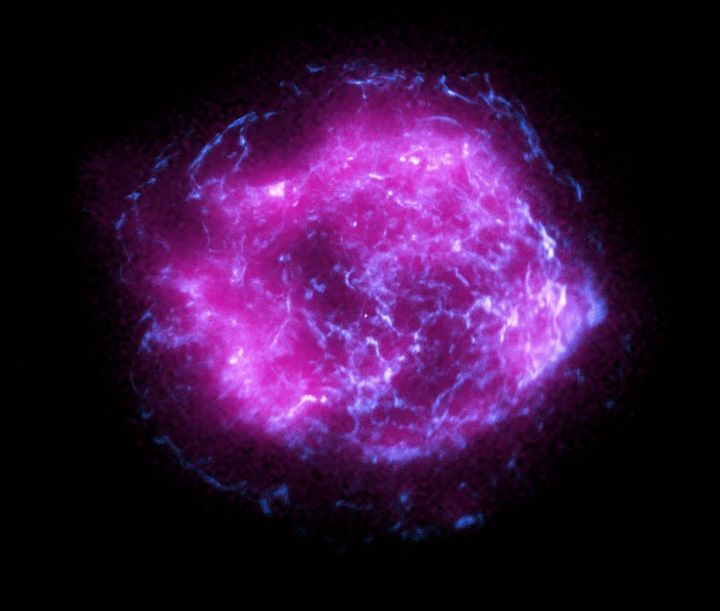17.02.2022

IXPE's first science image shows the supernova remnant Cassiopeia A. (Image credit: NASA/CXC/SAO/IXPE)
NASA's newly-launched X-ray hunting probe has snapped its first science image and — wow — it's spectacular.
The Imaging X-ray Polarimetry Explorer (IXPE) probe launched Dec. 9, 2021, on a mission to observe objects like black holes and neutron stars in X-ray light, shedding much-anticipated light on the inner workings of the cosmos. The probe spent its first month in space checking out its various systems to get ready to capture its first images, and now the IXPE team has released its very first science image.
The image shows Cassiopeia A, the remnants of a star that exploded as a supernova in the 17th century. That explosion sent shock waves outwards, heating up surrounding gasses and accelerating cosmic ray particles (high-speed electrons and atomic nuclei) to create a cloud of assorted matter, according to a statement from NASA. This cloud, as you can see in the striking image from IXPE, glows brilliantly in X-ray light.
It goes without saying that the image is visually stunning.
"The IXPE image of Cassiopeia A is bellissima, and we look forward to analyzing the polarimetry data to learn even more about this supernova remnant," Paolo Soffitta, the Italian principal investigator for IXPE at the National Institute of Astrophysics (INAF) in Rome, said in the NASA statement. ("Bellissima" means beautiful in Italian.)
Now, while the image's most striking feature is its almost-neon magenta color, it doesn't actually look like that in visible light. But this color, which represents X-ray radiation, is a helpful guide for scientists. The more saturated the color, the more intense the X-ray light. Additionally, veins of what resembles blue lightning in the image represent high energy X-rays seen by NASA's Chandra X-ray Observatory.
While the two telescopes both observe X-rays, they have different kinds of detectors so, by working together, they can produce more complete and detailed data, according to the statement.
Chandra's first image was also of Cassiopeia A after it launched all the way back in 1999. Chandra's early observations revealed that, at the center of the remnant, there must be a compact object like a black hole or neutron star.
"The IXPE image of Cassiopeia A is as historic as the Chandra image of the same supernova remnant," IXPE principal investigator Martin C. Weisskopf said in the NASA statement. "It demonstrates IXPE's potential to gain new, never-before-seen information about Cassiopeia A, which is under analysis right now."
Quelle: SC
+++
rIn time for Valentine’s Day, NASA’s Imaging X-Ray Polarimetry Explorer which launched Dec. 9, 2021, has delivered its first imaging data since completing its month-long commissioning phase.
All instruments are functioning well aboard the observatory, which is on a quest to study some of the most mysterious and extreme objects in the universe.
IXPE first focused its X-ray eyes on Cassiopeia A, an object consisting of the remains of a star that exploded in the 17th century. The shock waves from the explosion have swept up surrounding gas, heating it to high temperatures and accelerating cosmic ray particles to make a cloud that glows in X-ray light. Other telescopes have studied Cassiopeia A before, but IXPE will allow researchers to examine it in a new way.
In the image above, the saturation of the magenta color corresponds to the intensity of X-ray light observed by IXPE. It overlays high energy X-ray data, shown in blue, from NASA’s Chandra X-Ray Observatory. Chandra and IXPE, with different kinds of detectors, capture different levels of angular resolution, or sharpness. An additional version of this image is available showing only IXPE data. These images contain IXPE data collected from Jan. 11 to 18.
After Chandra launched in 1999, its first image was also of Cassiopeia A. Chandra’s X-ray imagery revealed, for the first time, that there is a compact object in the center of the supernova remnant, which may be a black hole or neutron star.
“The IXPE image of Cassiopeia A is as historic as the Chandra image of the same supernova remnant,” said Martin C. Weisskopf, the IXPE principal investigator based at NASA’s Marshall Space Flight Center in Huntsville, Alabama. “It demonstrates IXPE’s potential to gain new, never-before-seen information about Cassiopeia A, which is under analysis right now.”
A key measurement that scientists will make with IXPE is called polarization, a way of looking at how X-ray light is oriented as it travels through space. The polarization of light contains clues to the environment where the light originated. IXPE’s instruments also measure the energy, the time of arrival, and the position in the sky of the X-rays from cosmic sources.
“The IXPE image of Cassiopeia A is bellissima, and we look forward to analyzing the polarimetry data to learn even more about this supernova remnant,” said Paolo Soffitta, the Italian principal investigator for IXPE at the National Institute of Astrophysics (INAF) in Rome.
With polarization data from Cassiopeia A, IXPE will allow scientists to see, for the first time, how the amount of polarization varies across the supernova remnant, which is about 10 light-years in diameter. Researchers are currently working with the data to create the first-ever X-ray polarization map of the object. This will reveal new clues about how X-rays are produced at Cassiopeia A.
“IXPE's future polarization images should unveil the mechanisms at the heart of this famous cosmic accelerator,” said Roger Romani, an IXPE co-investigator at Stanford University. “To fill in some of those details, we’ve developed a way to make IXPE’s measurements even more precise using machine learning techniques. We’re looking forward to what we’ll find as we analyze all the data.”
IXPE launched on a Falcon 9 rocket from Cape Canaveral, and now orbits 370 miles (600 kilometers) above Earth’s equator. The mission is a collaboration between NASA and the Italian Space Agency with partners and science collaborators in 12 countries. Ball Aerospace, headquartered in Broomfield, Colorado, manages spacecraft operations.
Quelle: NASA


